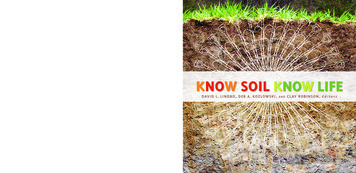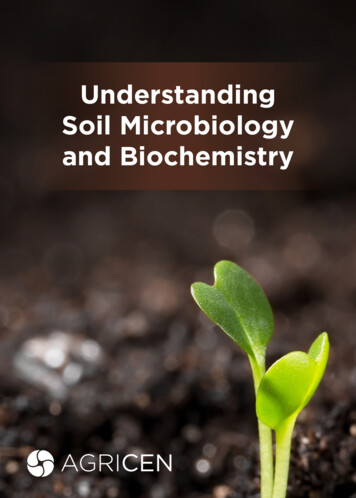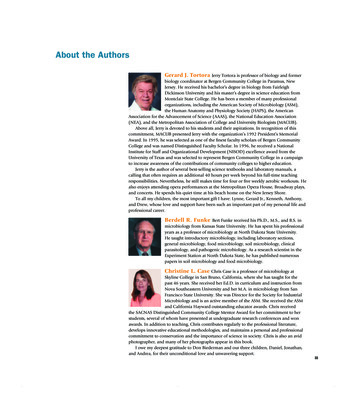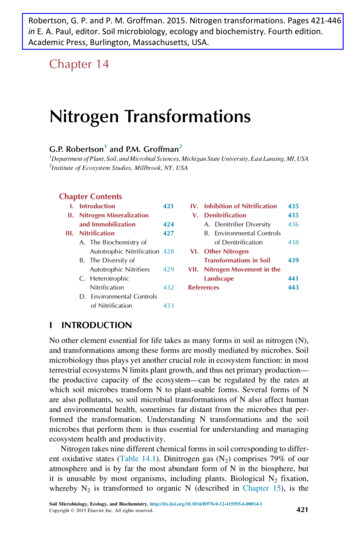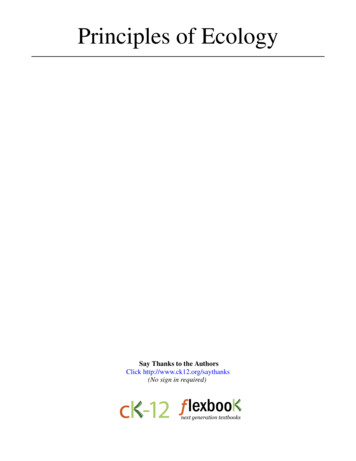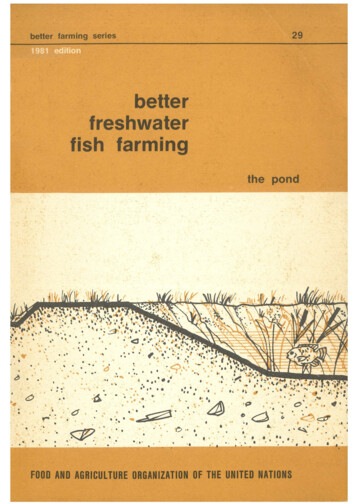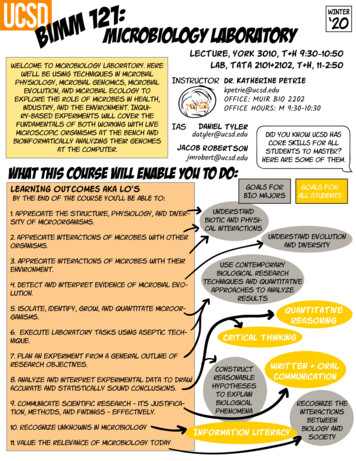
Transcription
Prelims-P546807.qxd11/20/0611:18 AMPage iSoil Microbiology,Ecology, andBiochemistry
Prelims-P546807.qxd11/20/0611:18 AMPage ii
Prelims-P546807.qxd11/20/0611:18 AMPage iiiSoil Microbiology,Ecology, andBiochemistryT H I R DE D I T I O NEditorEldor A. PaulAMSTERDAM BOSTON HEIDELBERG LONDONNEW YORK OXFORD PARIS SAN DIEGOSAN FRANCISCO SINGAPORE SYDNEY TOKYOAcademic Press is an imprint of Elsevier
Prelims-P546807.qxd11/20/0611:18 AMPage ivAcademic Press is an imprint of Elsevier30 Corporate Drive, Suite 400, Burlington, MA 01803, USALinacre House, Jordan Hill, Oxford OX2 8DP, UKThird edition 2007Copyright 2007, 1996, 1989, Elsevier Inc. All rights reserved.No part of this publication may be reproduced, stored in a retrieval system, or transmitted in anyform or by any means, electronic, mechanical, photocopying, recording, or otherwise, without theprior written permission of the publisher.Permissions may be sought directly from Elsevier’s Science & Technology RightsDepartment in Oxford, UK: phone: (44) 1865 843830, fax: (44) 1865 853333,e-mail: permissions@elsevier.com. You may also complete your request on-linevia the Elsevier homepage (http://elsevier.com), by selecting “Support & Contact”then “Copyright and Permission” and then “Obtaining Permissions.”NoticeNo responsibility is assumed by the publisher for any injury and/or damage to persons orproperty as a matter of products liability, negligence or otherwise, or from any use oroperation of any methods, products, instructions or ideas contained in the material herein.Recognizing the importance of preserving what has been written, Elsevier prints its bookson acid-free paper whenever possible.Library of Congress Cataloging-in-Publication DataSoil microbiology, ecology, and biochemistry / editor, Eldor A. Paul. — 3rd ed.p. cm.Rev. ed. of: Soil microbiology and biochemistry / E.A. Paul, F.E. Clark. 1989.Includes bibliographical references and index.ISBN 13: 978-0-12-546807-7 (hardcover : alk. paper)ISBN 10: 0-12-546807-5 (hardcover : alk. paper) 1. Soil microbiology. 2. Soil biochemistry.I. Paul, Eldor Alvin. II. Paul, Eldor Alvin. Soil microbiology and biochemistry.QR111.P335 2007579 .1757—dc222006036420For information on all Academic Press publicationsvisit our web site at www.books.elsevier.comTypeset by Charon Tec Ltd (A Macmillan Company), Chennai, Indiawww.charontec.comPrinted in the United States of America06 07 08 09 1010 9 8 7 6 5 4 3 2 1
Prelims-P546807.qxd11/20/0611:18 AMPage vContentsContributorsPreface xixxviiPARTIBackground1Soil Microbiology, Ecology and Biochemistryin PerspectiveE. A. PaulGeneral History and Scope 3Soil Microbiology 5Soil Ecology 10Soil Biochemistry 13In Perspective 19References and Suggested Reading21v
Prelims-P546807.qxd11/20/0611:18 AMPage viviContents2The Soil HabitatR. P. VoroneyIntroduction 25Soil Genesis and Formation of the Soil Habitat 26Soil Profile 29Physical Aspects of Soil 29Soil Texture 30Soil Structure 32Soil Habitat Scale and Observation 33Scale of Soil Habitat 33Pore Space 35Soil Solution Chemistry 39Soil pH 43Soil Temperature 43Soil Water Content 45Environmental Factors, Temperature and Moisture InteractionsReferences and Suggested Reading 49PART48IISOIL BIOTA3Physiological and Biochemical Methods forStudying Soil Biota and Their FunctionE. KandelerIntroduction 53Scale of Investigations and Collection of Samples 54Storage and Pretreatment of Samples 56Microbial Biomass 57Chloroform Fumigation Incubation and Extraction Methods 57Substrate-Induced Respiration 58Isotopic Composition of Microbial Biomass 58Signature Molecules as a Measure of Microbial Biomass and MicrobialCommunity Structure 59
Prelims-P546807.qxd11/20/0611:18 AMPage viiviiContentsATP as a Measure of Active Microbial Biomass 59Microbial Membrane Components and Fatty Acids 60Respiratory Quinones as a Measure of Structural DiversityErgosterol as a Measure of Fungal Biomass 63Lipopolysaccharides, Glycoproteins, and Cell Walls 64Growth Rates from Signature Molecules 65Physiological Analyses 65Culture-Based Studies 65Isolation and Characterization of Specific Organisms 66Soil Organic Matter Decomposition and Respiration 67Nitrogen Mineralization 72Activities and Locations of Enzymes 72Spectrophotometric Methods 73Fluorescence Methods 75Techniques for Imaging the Location of Enzymes 77Functional Diversity 77References and Suggested Reading 80624Molecular Methods for StudyingSoil EcologyJ. E. ThiesIntroduction 85Types and Structures of Nucleic Acids 86Use of Nucleic Acid Analyses for Soil Ecology Studies 88Direct Molecular Analysis of Soil Biota 90Nucleic Acid Hybridization 90Confocal Microscopy 91Biosensors and Marker Gene Technologies 92Extraction of Nucleic Acids (DNA/RNA) 93Choosing between DNA and RNA for Soil Ecology Studies 96Analysis of Nucleic Acid Extracts 96DNA:DNA Reassociation Kinetics 96Microarrays 98Restriction Fragment Length Polymorphism (RFLP) Analysis 100Cloning 101DNA Sequencing 102Stable Isotope Probing 102Partial Community Analyses—PCR-Based Assays 104Electrophoresis of Nucleic Acids 107
Prelims-P546807.qxd11/20/0611:18 AMPage viiiviiiContentsPCR Fingerprinting 107Similarity Analyses 112Level of Resolution 112Other Factors That May Affect Molecular AnalysesSample Handling 113Soil Chemical Factors 113Sampling Scale 114Summary 114References 1151135The ProkaryotesK. Killham and J. I. ProsserIntroduction 119Phylogeny 120Cultivated Organisms 120Uncultivated Organisms 121Phylogeny and Function 125General Features of Prokaryotes 126Cell Structure 127Unicellular Growth Forms 127Filamentous and Mycelial Growth 129Cell Walls 129Internal Structure 131Motility 132Metabolism and Physiology 132Carbon and Energy Sources 132Oxygen Requirements 133Substrate Utilization 134Autochthony and Zymogeny 136Oligotrophy, Copiotrophy, and the R–K Continuum 137Facultativeness 138Biodegradation Capacity 138Cellulose 138Pollutants 139Differentiation, Secondary Metabolism, and Antibiotic ProductionConclusions 142References and General Reading 143141
Prelims-P546807.qxd11/20/0611:18 AMPage ixixContents6Fungi and Eukaryotic AlgaeR. G. Thorn and M. D. J. LynchIntroduction 145Classification, Characteristics, and Ecological Roles in Soil 151Fungus-like Protists 151Fungi (Chytridiomycota, Glomeromycota, Zygomycota, Ascomycota, andBasidiomycota) 153Eukaryotic Algae 156References and Suggested Reading 1587Fauna: The Engine for Microbial Activity andTransportD. C. Coleman and D. H. WallIntroduction 163The Microfauna 166Methods for Extracting and Counting Protozoa 168Impacts of Protozoa on Ecosystem Function 168Distribution of Protozoa in Soil Profiles 169Rotifera 169Nematoda 170Nematode Feeding Habits 170Zones of Nematode Activity in Soil 173Nematode Extraction Techniques 174Microarthropods 174Enchytraeids 175Macrofauna 178Macroarthropods 178Importance of the Macroarthropods 179Oligochaeta (Earthworms) 179Formicidae (Ants) 183Termitidae (Termites) 183Summary 185References 186
Prelims-P546807.qxd11/20/0611:18 AMPage xxContentsPARTIIICONCEPTS AND INTERACTIONS8The Ecology of Soil OrganismsS. J. Morris and C. B. BlackwoodIntroduction 195Mechanisms That Drive Community Structure 197Physiological Limits 198Intraspecific Competition 199Dispersal in Space and Time 203Predicting Population Growth 204Interspecific Competition 204Direct Effects of Exploitation 207Indirect Effects of Exploitation 209Mutualisms 211Abiotic Factors 211Changes in Community Structure through Time and SpaceHistorical and Geographic Contingency 214Hierarchical Community Assembly Rules 215Ecosystem Dynamics 218Energy Flow 219Carbon, Nutrient, and Water Cycles 221Emergent Properties 224Conclusion 225References and Suggested Reading 2262129The Physiology and Biochemistry ofSoil OrganismsW. B. McGillIntroduction 231Metabolic Classifications of Soil Organisms 233Electrons and ATP 234Substrate-Level Phosphorylation 234
Prelims-P546807.qxd11/20/0611:18 AMPage xixiContentsElectron Transport Phosphorylation 235Overview of Mechanisms to Generate ATP and Reducing EquivalentsExamples of Soil Microbial Transformations 241Nitrogen Fixation 241Aerobic Chemolithotrophic Examples 242Oxidation of Reduced C 245How Can the Microbial Contributions Be Viewed in a Simplified andUnified Concept? 251A Model of Interconnected Cycles of Electrons 252The Anoxygenic Cycle 253The Oxygenic Cycle 253References 25623810The Ecology of Plant–Microbial MutualismsJ. Powell and J. KlironomosIntroduction 257Roots as an Interface for Plant–Microbial Mutualisms 258Mycorrhizal Symbioses 259Symbioses Involving N-Fixing Organisms 267Interactions among Mutualists 270Interactions with Pathogens 272Implications for Plant Populations and Communities 275Challenges in the Study of Interactions 276Conclusions 277References and Suggested Reading 27911Spatial Distribution of Soil OrganismsS. D. FreyIntroduction 283Geographical Differences in Soil Biota 285Association of Soil Organisms with Plants 287Spatial Heterogeneity of Soil Organisms 290
Prelims-P546807.qxd11/20/0611:18 AMPage xiixiiContentsVertical Distribution within the Soil Profile 292Microscale Heterogeneity in Microbial PopulationsReferences and Suggested Reading 299PART296IVBIOCHEMISTRY AND BIOGEOCHEMISTRY12Carbon Cycling and Formation of SoilOrganic MatterW. HorwathIntroduction 303Long-Term Carbon Cycle 304The Short-Term C Cycle 307Ecosystem C Cycling 309Composition and Turnover of C Inputs to Soil 312Plant and Microbial Lipids 315Starch 315Hemicelluloses, Pectins, and Cellulose 317Lignin 320Other Plant Cell Wall Carbohydrates and Proteins 324Plant Secondary Compounds 325Roots and Root Exudates 325Cell Walls of Microorganisms 327Soil Organic Matter 329Soil Organic Matter Formation 329Classical Fractions of Soil Organic Matter 332Physical Analysis of Soil Organic Matter Fractions 333Structure of Soil Organic Matter 335Quantity and Distribution of Organic Matter in Soils 335Role of Methane in the C Cycle 336Future Considerations 337References and Suggested Reading 337
Prelims-P546807.qxd11/20/0611:18 AMPage xiiixiiiContents13Nitrogen TransformationsG. P. Robertson and P. M. GroffmanIntroduction 341Nitrogen Mineralization and Immobilization 343Nitrification 347The Biochemistry of Autotrophic Nitrification 347The Diversity of Autotrophic Nitrifiers 349Heterotrophic Nitrification 352Environmental Controls of Nitrification 353Inhibition of Nitrification 355Denitrification 355Denitrifier Diversity 356Environmental Controls of Denitrification 358Other Nitrogen Transformations in Soil 359Nitrogen Movement in the Landscape 360References and Suggested Reading 36214Biological N InputsP. J. Bottomley and D. D. MyroldGlobal N Inputs 365Biological Nitrogen Fixation 367Free-Living N2-Fixing Bacteria 372Associative N2-Fixing Bacteria 373Phototrophic Bacteria 374Symbiotic N2-Fixing Associations between Legumes and Rhizobia 375Formation of the Symbiosis 375Rhizobial Nodulation Genes 378Plant Nodulation Genes 380Development of BNF and Nitrogen Assimilatory Processes in Nodules 381Symbiotic Associations between Actinorhizal Plants and Frankia 383Biotechnology of BNF 385Acknowledgments 386References and Suggested Reading 386
Prelims-P546807.qxd11/20/0611:18 AMPage xivxivContents15Soil Biogeochemical Cycling of InorganicNutrients and MetalsA. F. PlanteIntroduction 389Phosphorus 391The Soil Phosphorus Cycle 391Nature and Forms of Phosphorus in Soil 393Biological Importance of Phosphorus 397Microbial Transformations of Phosphorus 398Sulfur 400The Soil Sulfur Cycle 400Nature and Forms of Sulfur in Soil 402Biological Importance of Sulfur 406Microbial Transformations of Sulfur 406Micronutrients and Trace Metals 413Micronutrient and Trace Metal Cycling in Soil 413Nature and Forms in Soil 414Biological Importance 415Microbial Transformations 417Environmental Significance of P, S, and Metal Biogeochemistry 423Eutrophication 423Acid Sulfate Soils 423Acid Mine Drainage 424Heavy Metal Mining Using Microbes 426Microbial Corrosion of Buried Iron and Concrete Pipes 427Conclusion: Microorganisms as Unifiers of Elemental Cycles in Soil 430References and Suggested Reading 43016The Dynamics of Soil Organic Matter andNutrient CyclingA. F. Plante and W. J. PartonIntroduction 433Reaction Kinetics 434Zero-Order Reactions 434First-Order Reactions 435
Prelims-P546807.qxd11/20/0611:18 AMPage xvxvContentsEnzymatic Kinetics 436Microbial Growth 437Modeling the Dynamics of Decomposition and Nutrient TransformationsSimple Models 441Multicompartmental Models 443Alternative SOM Models 453Models of Non-C Nutrient Elements 454Ecosystem Models: Interactions of Nutrient Cycling and SOMDynamics 457Establishing Pool Sizes and Kinetic Constants 459Model Selection and Evaluation 461References and Suggested Reading 464PART439VSoil Organisms: Man and Nature17Management of Organisms and Their Processesin SoilsJ. L. Smith and H. P. CollinsIntroduction 471Changing Soil Organism Populations and Processes 473Tillage and Erosion 474Rangeland and Forest Health 477Alternative Agricultural Management 480Organic Agriculture 480Biodynamic Agriculture 482Composting 483Crop Rotations and Green Manures 486The Potential for Managing Microorganisms and Their Processes 487Management of Native and Introduced Microorganisms 487Managing Microbial Populations as Agents of Biological Control 488Control of Insects 490Weed Control 492Use of Synthetic and Natural Compounds to Modify Soil Communitiesor Functions 493Manipulating Soil Populations for Bioremediation of Xenobiotics 495
Prelims-P546807.qxd11/20/0611:18 AMPage xvixviContentsConcluding Comments on Microbial EcologyReferences and Suggested Reading 50049918Soil Microbiology, Ecology, and Biochemistryfor the 21st CenturyJ. SchimelIntroduction 503Soil Community Ecology—Controls over Population and CommunityDynamics 506Microbial Life at the Microbial Scale—the Microbial Landscape 507A Whole Profile Perspective 509Scaling to the Ecosystem 510Application 511Conclusions 512References 512Index515
Prelims-P546807.qxd11/20/0611:18 AMPage xviiContributorsChristopher B. Blackwood Department of Biological Sciences, Kent StateUniversity, Kent, OH 44242Peter J. Bottomley Department of Crop and Soil Science, Oregon State University,Corvallis, PR 97331-3804David C. Coleman Institute of Ecology, University of Georgia, Athens,GA 30602-2360Harold P. Collins USDA-ARS, Vegetable and Forage Research Unit, Prosser,WA 99350Serita Frey Department of Natural Resources, University of New Hampshire,Durham, NH 03824Peter M. Groffman Institute of Ecosystem Studies, Millbrook, NY 12545-0129William H. Horwath Department of Land, Air, and Water Resources, Universityof California-Davis, Davis, CA 95616-8627Ellen Kandeler Institute of Soil Science and Land Evaluation, Soil BiologySection, University of Hohenheim, D-70599 Stuttgart, GermanyKen Killham School of Biological Sciences, University of Aberdeen, AberdeenAB24 3UU, ScotlandJohn Klironomos Department of Integrative Biology, College of BiologicalSciences, University of Guelph, Guelph, ON, N1G 2W1 CanadaMichael Lynch Department of Biology, University of Waterloo, Waterloo, OntarioN2L 3G1 CanadaW. Bill McGill University of Northern British Columbia, College of Science andManagement, Prince George, BC, Canada V2N 4Z9xvii
Prelims-P546807.qxdxviii11/20/0611:18 AMPage xviiiContributorsSherri J. Morris Biology Department, Bradley University, Peoria, IL 61625David Myrold Department of Crop and Soil Science, Oregon State University,Corvallis, PR 97331-3804Eldor A. Paul Natural Resource Ecology Laboratory and Soil and Crop Sciences,Colorado State University, Fort Collins, CO 80523-1499William Parton Natural Resource Ecology Laboratory, Colorado State University,Fort Collins, CO 80523-1499Alain Plante Department of Earth and Environmental Science, University ofPennsylvania, Philadelphia, PA 19104-6316Jeff Powell Department of Integrative Biology, College of Biological Sciences,University of Guelph, Guelph, ON, N1G 2W1 CanadaJim I. Prosser School of Biological Sciences, University of Aberdeen, Aberdeen4,Scotland AB24 3UU United KingdomG. Philip Robertson Department of Crop and Soil Sciences and W. K. KelloggBiological Station, Michigan State University, Hickory Corners, MI 49060Joshua P. Schimel Department of Ecology, Evolution, and Marine Biology,University of California-Santa Barbara, Santa Barbara, CA 93106-9610Jeffrey L. Smith USDA-ARS, Washington State University, Pullman, WA99164-6421Janice E. Thies Department of Crop and Soil Science, Cornell University,Ithaca, NYR. Greg Thorn Department of Biology, University of Western Ontario, London,ON, N6A 5B7 CanadaPaul Voroney Land Resource Science, University of Guelph, Guelph, ON, CanadaN1G 2W1Diana H. Wall Natural Resource Ecology Laboratory and Department of Biology,Colorado State University, Fort Collins, CO 80523-1499
Prelims-P546807.qxd11/20/0611:18 AMPage xixPrefaceSoil microbiology traditionally has been the study of microorganisms and theirprocesses in soil. The interaction of organisms with each other and their environments involves soil ecology. Soil biochemistry includes microbial processes, soilenzymes, and the formation and turnover of soil organic matter. Soil, in thenonengineering definition, is usually defined as the surface of the earth affected byplant roots, even though life, especially that of microorganisms, occurs at greatdepths in geological deposits, caves, and sediments. Although the organismsinvolved are often different, their ecological and abiotic controls and the productsof their metabolism have great similarities in all locations. Thus, there is now arecognized similarity and interaction with soil and biogeochemical studies inmarine and fresh water systems, sediments, and the atmosphere. What we knowfrom these processes on earth will also guide future extraterrestrial investigationsand, as a result, the number of people interested in this field has greatly increased.The textbook “Soil Microbiology and Biochemistry” by Paul and Clark (1989,1996) is available in Chinese and Korean translations. It has been incorporatedinto the teaching of engineering, biogeochemistry, ecology, and general biology ina variety of university departments, including those of private, undergraduate, andteaching universities, and is widely used in many research applications.The biological processes that occur in soil are intertwined with and inseparablefrom activities of the soil fauna, which feed on plants, soil microorganisms, andlitter. Their larger forms act as environmental engineers through their soil-mixingfunctions. They also contain microbial endophytes that carry out much of theirdecomposition function. The name of this edited volume has been changed toreflect its broader applicability and has been expanded to include both more basicand applied approaches. Soil microbiology, ecology, and biochemistry are beingxix
Prelims-P546807.qxdxx11/20/0611:18 AMPage xxPrefaceused in a broad range of applications from agronomy, plant pathology, general ecology, microbial ecology, engineering, organic agriculture, forestry, range management, and global change. We have thus included chapters on invertebrate–microbialinteractions, basic physiology, and ecological interpretations. Information on themanagement of microorganisms and their reactions has been expanded while wehave strived to retain readability, conciseness, and a reasonable cost.The definition of microbiology is usually associated with organisms not seenwithout the use of a microscope, although this does not apply to many fungallichen and algal growth forms. The communal structure of the Armillaria associated with tree roots in a number of areas is hectares in size, although it is still afungus by definition. The soil fauna also range in size and diversity. This bookreflects the great advances in molecular techniques, the broader use of tracers, andthe maturation of modeling in interpretation of data and development of new concepts. We finally know enough about our field to be able to impact management ofsuch modern problems as biodiversity, biological invasions, global change,ecosystem services, sustainable agriculture, and urban ecosystems. This textbookhas been designed to provide access to necessary knowledge for those working inthese diverse fields. The authors of the individual chapters hope that the readerswill find this a readable, accessible introduction to both the concepts involved andthe background literature.
Ecology, and Biochemistry THIRD EDITION Editor Eldor A. Paul Prelims-P546807.qxd 11/20/06 11:18 AM Page iii. Academic Press is an imprint of Elsevier 30 Corporate Drive, Suite 400, Burlington, MA 01803, USA Linacre House, Jordan Hil
